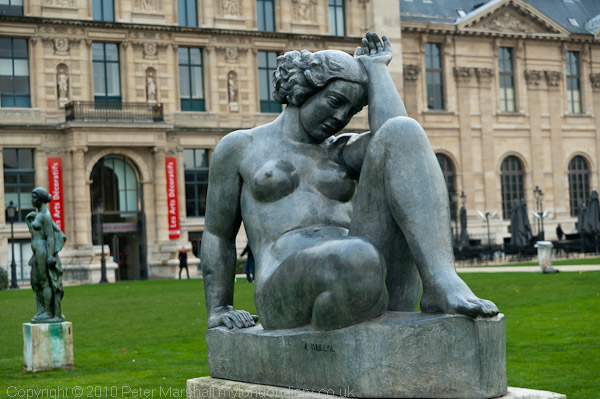
Finally I’d finished looking at Paris Photo, ending with another look at the BMW Prize pictures (and as usual I wouldn’t have chosen the same winner though I’ll save writing about it for another day) and then, right at the exit and rather more to my taste a show of work by Daido Moriyama along with a book including the same I was tempted by, but decided I didn’t want to have yet another thing to carry around with me. Leaving the show I emerged into the Jardin du Carrousel only to find myself surrounded by naked women.
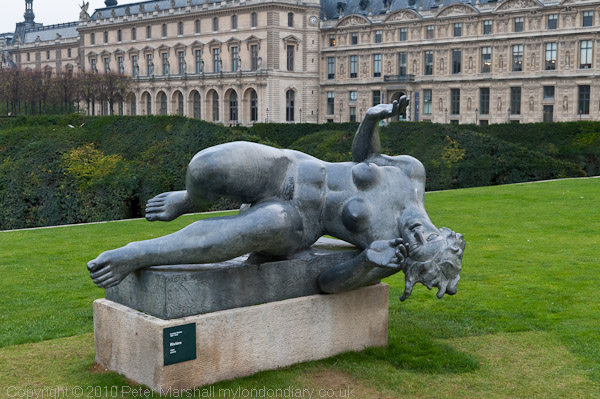
Not of course in the flesh (apart from anything else it was a cold, dull day), but in bronze, a whole flock of sculptures by Aristide Maillol many surrounded by the small hedges of the formal garden. Apparently 18 of these large figures were placed there in the 1960s, thanks to André Malraux and the model for some of them, Maillol’s last model Dina Vierny. I had a few minutes to spare and wandered around photographing some of them as I made a wandering path out of the gardens of the Louvre towards the river.
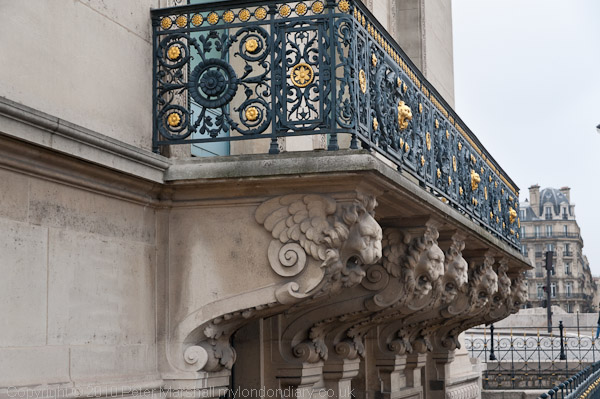
I could have walked across the Pont Royal or the Pont du Carrousel, but decided to make my way alongside the river to the Pont des Arts, leading directly opposite to the Instutut De France, stopping on my way to take a few pictures. There were two police on horseback at the lower level on the Quai opposite, stationary and facing towards me across the river. They had bright blue jackets and were underneath a long line of trees with yellow leaves.
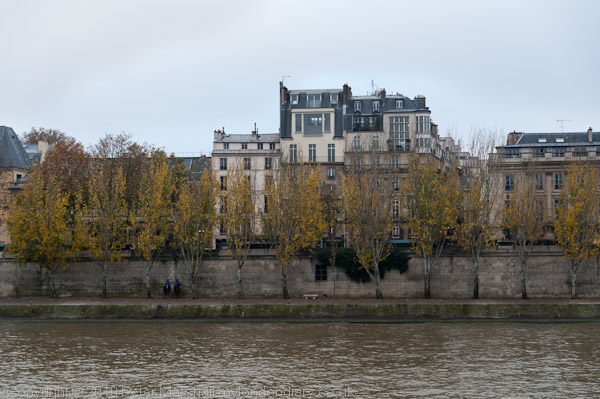
Not really my kind of picture, but I thought I’d give it a try anyway, wondering if I could make it work. The Seine is pretty wide here and the longest lens I had for the D700 was a Sigma 24-70mm f2.8, so those blue jackets would be fairly small on the image. I took a frame, then realised it would be better to use a slower ISO to get more detail.
It was fairly dull and I hadn’t bothered to alter the ISO from the 1600 I had been using inside Paris Photo, but I now set it to ISO 320 (though as I had an exposure bias of -2/3 stop I suppose it was truly ISO 500.) Everything in the picture that needed to be sharp was on the other side of the river, so I hardly needed much depth of field, but I wanted to use the lens around its optimum aperture for sharpness. The lens isn’t pin sharp wide open, but its pretty good at f4, and although I’ve not tested it, will start to lose sharpness through diffraction probably at anything smaller than f8. I settled for f5, which gave me a shutter speed of 1/100. At 70mm I would expect to hold the lens steady at that, especially as I was leaning on a small wall to take the picture.
It doesn’t work at the size it is on this blog, though if you open it in its own window in your browser (in Firefox, right click and select ‘view image’) you can just about make out that there is some blue there, but on a large print it does, or at least in the one frame where the two men are both looking directly at me. Some pictures do need to be fairly large, though I’d spent quite a lot of time in the exhibition hall earlier thinking many of the large large colour images there would look better very much smaller.
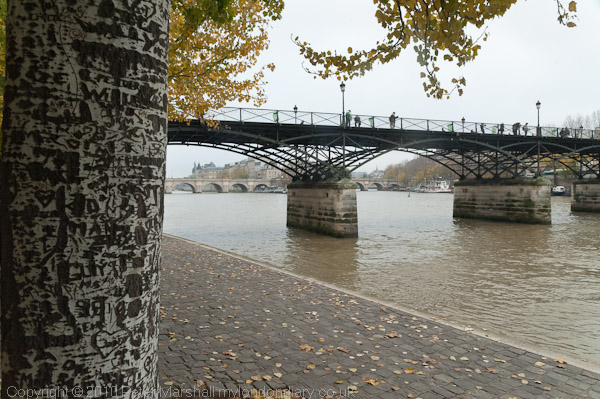
But I think some of the other pictures I took as I wandered along are better, despite needed rather less thinking about from a technical point of view, although they are unlikely ever to end up as being more than a picture on a birthday card from us.
Campagne française – Fragments
My destination in the Institut opposite was a landscape show, Thibaut Cuisset‘s Campagne française – Fragments, which according to the Mois de la Photo programme ended on 17 Nov, but was actually continuing until 21 Nov. The show included 40 of his pictures and most of them are on the web site.
They are quiet and precise views, avoiding the kind of drama or anecdote that characterises much landscape work. They are in a way typical views, images that attempt to show the essence of the place. As the notes on the pictures state, “il ne cherche pas le scoop optique” and there is nothing false or forced. The colours are natural and accurate (or at least appear so), the lighting flat. The subject, the French countryside is clearly shown as it is, it’s nature shaped by the work and actions of its inhabitants.
Cuisset has photographed in countries around the world over more than 20 years – and on the Filles du Calvaire site you can see work from Japan, Turkey, Corsica, Italy, Spain, Switzerland, Australia and Syria as well as France.
Perhaps what I found most surprising is that work that is as quiet and considered as this was the product of the winner of a major prize, the Prix Photo 2009 de lAcadémie des Beaux-Arts, produced with the aid of its 15,000 Euros. It seems to me that his work is very much the kind of work that could and probably would be overlooked or dismissed were it being produced by someone outside the charmed circle of the art establishment.
I’m not generally a great fan of landscape photography – too often it seems to attract photographers whose idea of creativity is to use a graduated tobacco filter and turn up the saturation beyond belief, or large-format clones of St Ansel without his originality or talent. But Cuisset shows that it can be done sensitively and well – and still be recognised, at least by the French establishment.
UPDATE:
PARIS PHOTO SUPPLEMENT is now on MY LONDON DIARY
- Wednesday
- Thur am: 9e, 2e & Paris Photo
- In the 3eme
- Brian Griffin – The Black Country
- Jim & Millie’s Party
- Wandering in the 20e
- Lab East at Paris Photo
- To Saint-Germain-des-Prés
- Montmartre at Night
- Street Photography in the 10e
- Guided tour of the Photo-OFF
- Dinner at Chartier
- The Marais
- BnF and FIAP
- Monday Wandering